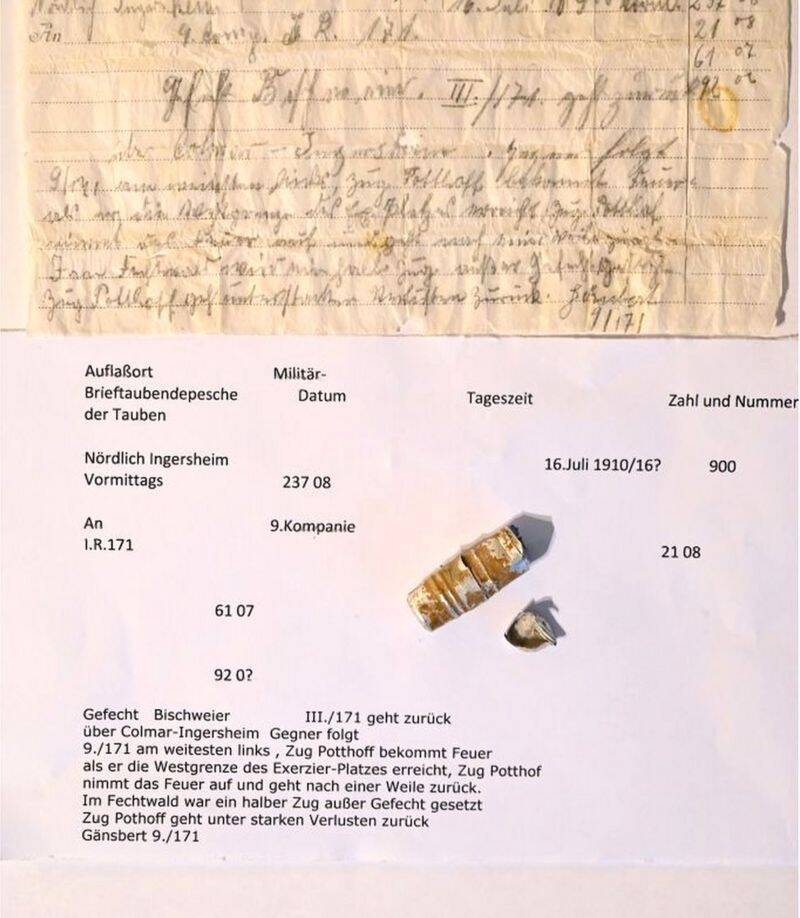The carrier capsule contained a note handwritten by a Prussian soldier.

Sébastien Bozon/AFP/Getty ImagesA tiny capsule containing correspondence from World War 1 was uncovered in France.
An elderly French couple was taking a walk through a field in September when they spotted a peculiar object. It turned out to be a tiny capsule with a spectacular message inside: a 100-year-old handwritten note from a World War I soldier.
According to the Guardian, the note was written in German by a Prussian soldier based in Ingersheim. The region is now part of France’s Grand Est but was then still part of Germany. The note had been sent by carrier pigeon to the soldier’s superior officer.
The elderly couple who unearthed the long-lost letter brought it to the nearby Linge Museum at Orbey in eastern France. The museum is dedicated to the World War I battle known as Le Linge, or The Linge, which raged from July 20 until Oct. 15, 1915.
During the battle at The Linge, French forces went up against German troops in the countryside where a bevy of war artifacts have been uncovered over the last decades, including old weapons, ammunition, and personal items which are mostly kept at the local museum.
An estimated 17,000 lives were lost in the battle. However, despite this terrible loss of life, the frontlines that were established here remained mostly unchanged when the war finally drew to a close in 1918.

Getty ImagesA typed out version of the letter’s contents, deciphered at the Linge Museum at Orbey.
Museum Curator Dominique Jardy enlisted the help of a German-speaking colleague to decipher the century-old war artifact. The barely legible letter appeared to have been dated either in 1910 or 1916, but its content which includes sensitive military information places it firmly in the midst of the First World War.
The letter contained the following message:
“Platoon Potthof receives fire as they reach the western border of the parade ground, platoon Potthof takes up fire and retreats after a while. In Fechtwald half a platoon was disabled. Platoon Potthof retreats with heavy losses.”
Jardy described the letter as a “super rare” discovery. The artifact is slated to become a permanent part of the Linge Museum’s exhibit.
The discovery of old letters sent by soldiers is not that uncommon, and sometimes they wield a deeper glimpse of what life was like in the military during the most uncertain of times.
In August 2019, an Alaskan man out looking for firewood accidentally came across a message in a bottle that had been written by a Soviet sailor in the 1960s, a particularly fraught time with the Cold War and mounting social unrest under the Communist Party.

Photo12/UIG/Getty ImagesA photograph from the Battle of the Somme, colorized by Matt Loughrey.
The message was written by a former Soviet sea captain named Anatoly Botsanenko who was aboard the Soviet vessel Sulak. But unlike the letter found in Orbey, Botsanenko’s letter wasn’t about the conflicts he had been involved in at sea. Instead, it was a sentimental call for health and happiness addressed to the stranger that would come across his bottled message:
“Sincere greetings! From the Russian Far East Fleet mother ship VRXF Sulak. I greet you who finds this bottle and request that you respond to the address Vladivostok -43 BRXF Sulak to the whole crew. We wish you good health and long years of life and happy sailing.”
The discovery of the letter went viral and led to a search for the author of the note who many believed was still alive. State-owned TV station Russia-1 successfully tracked down the former sea captain; he was 86 years old at the time of his letter’s discovery.
During an interview with Botsanenko about his letter, the Soviet veteran spoke about his military service. At one point, when the interviewer informed Botsanenko that his old ship had been put out of commission and sold for scraps in the 1990s, the former Navy man was overcome by emotion.
Letters from the war are among the most intriguing relics of the past that historians can come across. Whether containing top-secret intelligence or personal correspondence, these letters provide an intimate look at some of the most extreme events that have occurred in history.
Next, go inside the the Battle of the Somme, one of the most horrific battles of The Great War. Next, take a look inside the trenches of World War I through these striking photographs.




